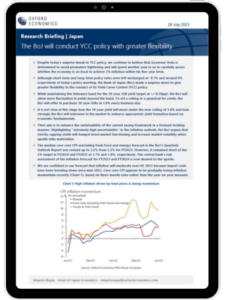The BoJ will conduct YCC policy with greater flexibility

Despite today’s (28th July) surprise tweak to YCC policy, we continue to believe that Governor Ueda is determined to avoid premature tightening and will spend another year or so to carefully assess whether the economy is on track to achieve 2% inflation within his five-year term.
What you will learn:
- Their aim is to enhance the sustainability of the current easing framework in a forward-looking manner. Highlighting “extremely high uncertainties” in the inflation outlook, the BoJ argues that strictly capping yields will hamper bond market functioning and increase market volatility when upside risks materialize.
- The median core-core CPI (excluding fresh food and energy) forecast in the BoJ’s Quarterly Outlook Report was revised up to 3.2% from 2.5% for FY2023. However, it remained short of the 2% target in FY2024 and FY2025 at 1.7% and 1.8%, respectively. The central bank’s risk assessment of the inflation forecast for FY2023 and FY2024 is now skewed to the upside.
- We are confident in our forecast that inflation will moderate over H2 2023 because import costs have been trending down since mid-2022. Core-core CPI appears to be gradually losing inflation momentum recently, based on three-month rates rather than the year-on-year measure.
Tags:
Related posts

Post
How Asia’s supply chains are changing | Techonomics Talks
Global supply chains have continued to expand, despite talk of deglobalization and nearshoring. US and Japan have started to de-couple from China, but other G7 countries grow more dependent on Chinese inputs. Several "hotspots" are emerging across Asia with multiple winning formulas.
Find Out More
Post
BoJ to raise its policy rate cautiously to 1% by 2028
We now project that the Bank of Japan will start to raise its policy rate next spring assuming another robust wage settlement at the Spring Negotiation. If inflation remains on a path towards 2%, the BoJ will likely raise rates cautiously to a terminal rate of around 1% in 2028.
Find Out More
Post
Japan inflation to rise to 1.8%, but downside risks are high
Reflecting a surprisingly strong Spring Negotiation result and weaker yen assumption, we have upgraded our baseline wage and inflation forecasts. We now project higher wage settlements will push inflation towards 1.8% by 2027. Uncertainty is high, however.
Find Out More